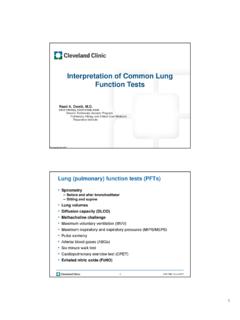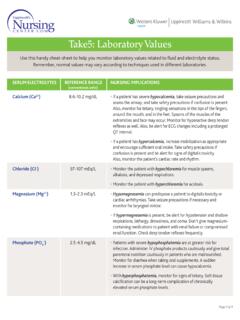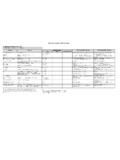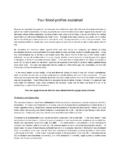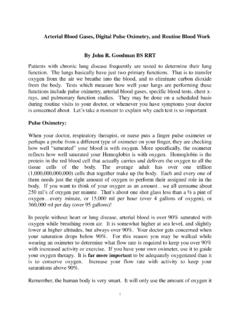Transcription of TOXICITY SUMMARY FOR MANGANESE - hydratechnm.org
1 TOXICITY SUMMARY FOR MANGANESE July 1995 Prepared by: A. A. Francis and C. Forsyth Chemical Hazard Evaluation Group Biomedical and Environmental Information Analysis Section Health Sciences Research Division Oak Ridge National Laboratory* Oak Ridge, Tennessee Prepared for: OAK RIDGE RESERVATION ENVIRONMENTAL RESTORATION PROGRAM *Managed by Lockheed Martin Energy Systems, Inc., for the Department of Energy under Contract No. DE-AC05-84OR21400 iv EXECUTIVE SUMMARY MANGANESE is an essential trace element in humans that can elicit a variety of serious toxic responses upon prolonged exposure to elevated concentrations either orally or by inhalation. The central nervous system is the primary target. Initial symptoms are headache, insomnia, disorientation, anxiety, lethargy, and memory loss.
2 These symptoms progress with continued exposure and eventually include motor disturbances, tremors, and difficulty in walking, symptoms similar to those seen with Parkinsonism. These motor difficulties are often irreversible. Based on human epidemiological studies, mg/kg/day for drinking water exposure and mg/m3 in air for inhalation exposure have been estimated as lowest-observed-adverse-effect levels (LOAELs) for central nervous system effects. Effects on reproduction (decreased fertility, impotence) have been observed in humans with inhalation exposure and in animals with oral exposure at the same or similar doses that initiate the central nervous system effects. An increased incidence of coughs, colds, dyspnea during exercise, bronchitis, and altered lung ventilatory parameters have also been seen in humans and animals with inhalation exposure.
3 A possible effect on the immune system may account for some of these respiratory symptoms. Because of the greater bioavailability of MANGANESE from water, separate reference doses (RfD) for water and diet were calculated. A chronic (EPA 1995) and subchronic RfD (EPA 1994) for drinking water of mg/kg/day has been calculated by EPA from a human no-observed-adverse-effect level (NOAEL) of mg/kg/day; the NOAEL was determined from an epidemiological study of human populations exposed for a lifetime to MANGANESE concentrations in drinking water ranging from 2300 g/L (Kondakis et al. 1989). A chronic (EPA 1995) and subchronic RfD (EPA 1994) of mg/kg/day for dietary exposure has been calculated by EPA from a human NOAEL of mg/kg/day, which was determined from a series of epidemiological studies (Schroeder et al.)
4 1966, WHO 1973, NRC 1989). Large populations with different concentrations of MANGANESE in their diets were examined. No adverse effects that were attributable to MANGANESE were seen in any of these groups. For both the drinking water and dietary values, the RfD was derived from these studies without uncertainty factors since MANGANESE is essential in human nutrition and the exposure of the most sensitive groups was included in the populations examined. EPA (1995) indicates that the chronic RfD values are pending change. A reference concentration (RfC) of g/m3 (EPA 1995) for chronic inhalation exposure was calculated from a human LOAEL of mg/m3 for impairment of neurobehavioral function from an epidemiological study by Roels et al. (1992). The study population was occupationally exposed to airborne MANGANESE dust with a median concentration of mg/m3 for to years with a mean duration of years.
5 Neurological examinations, psychomotor tests, lung function tests, blood tests, and urine tests were used to determine the possible effects of exposure. The LOAEL was derived from an occupational-lifetime integrated respirable dust concentration of MANGANESE dioxide expressed as mg MANGANESE /m3 years. Confidence in the inhalation RfC is rated medium by the EPA. Some conflicting data exist on possible carcinogenesis following injections of MANGANESE chloride and MANGANESE sulfate in mice. However, the EPA weight-of-evidence classification v is: D, not classifiable as to human carcinogenicity based on no evidence in humans and inadequate evidence in animals (EPA 1995). 1 1. INTRODUCTION MANGANESE (CAS registry number 7439-96-5) makes up about of the earth's crust and is the 12th most abundant element.
6 It can exist in oxidation states from -3 to +7, the most common being +4 in the chemical form of MANGANESE dioxide (Keen and Leach 1988). The oxides and peroxides are used in industry as oxidizers, and the metal is used for manufacturing metal alloys to increase hardness and corrosion resistance. In living systems, MANGANESE is an essential element that is found most often in the +2 valence (Keen and Leach 1988, Stokinger 1981). Normal nutritional requirements of MANGANESE are satisfied through the diet, which is the normal source of the element, with minor contributions from water and air (EPA 1984). The National Research Council (NRC 1989) recommends a dietary allowance of 2 to 5 mg/day for a safe and adequate intake of MANGANESE for an adult human. Toxic exposures occur largely due to particulate material in the air from mining and manufacturing activity.
7 2. METABOLISM AND DISTRIBUTION Intestinal absorption has been estimated to be between 3 and 10% of the amount of MANGANESE ingested and is a multiple-step process similar to and involving some of the same binding sites as in iron absorption (EPA 1995). Experiments with isolated rat intestines indicate that MANGANESE absorption is carrier-mediated with saturation occurring at mM (Testolin et al. 1993). The absorption of MANGANESE by inhalation depends on the particle size. The larger particles are cleared from the respiratory tract by the cilia and swallowed; whereas, the fine particles (< microns) are deposited in the lungs and must be cleared by absorption into the blood and lymph circulation (EPA 1995). It is estimated that 60 to 70% of the inhaled particles are eventually swallowed (Stokinger 1981).
8 DISTRIBUTION Once absorbed, MANGANESE is transported to organs rich in mitochondria (in particular the liver, pancreas, and pituitary) where it is rapidly concentrated. Accumulation of MANGANESE in the central nervous system following an intraperitoneal or intramuscular injection occurs slowly reaching a maximum in about 30 days. Distribution is homogeneous in the brain with lower concentrations in the spinal cord. The average turnover time in the central nervous system is reported to be about 110 days following intraperitoneal injection and about 55 days for intramuscular injection (Stokinger 1981). 2 METABOLISM MANGANESE does not undergo metabolism; it is absorbed and excreted unchanged. However, MANGANESE is an essential trace element and is involved as an activator or cofactor with a number of diverse enzymes involved with energy metabolism, digestion, and lipid and protein metabolism (Orten and Neuhaus 1975).
9 EXCRETION The normal adult body pool of about 20 mg is maintained by the liver, and excess MANGANESE is excreted into the intestine via the bile. This control is achieved with a daily intake of 10 to 20% of the total pool; therefore, relatively large amounts are handled by this mechanism. The normal urinary level of MANGANESE averages about g/L with a range of about to g/L. Urinary levels over 10 g/L are indicative of MANGANESE overexposure (Stokinger 1981). 3. NONCARCINOGENIC HEALTH EFFECTS ORAL EXPOSURES Acute TOXICITY Human Information on the acute oral TOXICITY of MANGANESE in humans was unavailable. Animal Due to the control exerted by mammals over MANGANESE absorption and excretion, acute oral TOXICITY is observed only after relatively large doses. However, several LD50 values have been calculated.
10 In one oral study using Sprague-Dawley rats, MANGANESE dichloride tetrahydrate was given by stomach tube, and the animals were observed for 14 days. The LD50 was calculated to be 1484 mg/kg or mmole/kg. The MANGANESE concentrations in the liver, kidney, spleen, heart, testes, brain, and blood of the surviving animals returned to control values within the 14-day period (Holbrook et al. 1975). Other oral values include an LD50 of 1715 mg/kg for MANGANESE dichloride in mice and 3730 mg/kg for manganese2+ acetate in rats (Lewis and Sweet 1984). Potassium permanganate, a strong oxidizing agent, is an irritant to mucosal tissues, is hemolytic, and damages capillaries regardless of the route. An oral LD50 of 1090 mg/kg has been determined for potassium permanganate in rats (Stokinger 1981).

